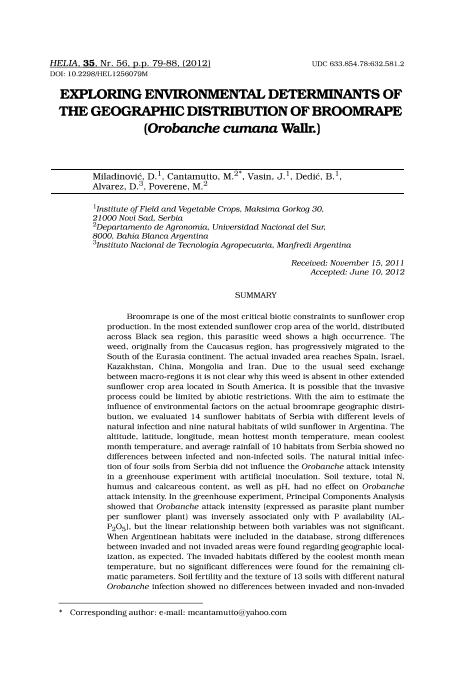Mostrar el registro sencillo del ítem
dc.contributor.author
Miladinović, D.
dc.contributor.author
Cantamutto, Miguel Ángel

dc.contributor.author
Vasin, J.
dc.contributor.author
Dedić, B.
dc.contributor.author
Alvarez, D.
dc.contributor.author
Poverene, María Mónica

dc.date.available
2019-05-28T18:06:53Z
dc.date.issued
2012-12
dc.identifier.citation
Miladinović, D.; Cantamutto, Miguel Ángel; Vasin, J.; Dedić, B.; Alvarez, D.; et al.; Exploring the environmental determinants of the geographic distribution of broomrape (Orobanche cumana Wallr.); University of Novi Sad; Helia; 35; 56; 12-2012; 79-88
dc.identifier.issn
1018-1806
dc.identifier.uri
http://hdl.handle.net/11336/77328
dc.description.abstract
Broomrape is one of the most critical biotic constraints to sunflower crop production. In the most extended sunflower crop area of the world, distributed across Black sea region, this parasitic weed shows a high occurrence. The weed, originally from the Caucasus region, has progressively migrated to the South of the Eurasia continent. The actual invaded area reaches Spain, Israel, Kazakhstan, China, Mongolia and Iran. Due to the usual seed exchange between macro-regions it is not clear why this weed is absent in other extended sunflower crop area located in South America. It is possible that the invasive process could be limited by abiotic restrictions. With the aim to estimate the influence of environmental factors on the actual broomrape geographic distribution, we evaluated 14 sunflower habitats of Serbia with different levels of natural infection and nine natural habitats of wild sunflower in Argentina. The altitude, latitude, longitude, mean hottest month temperature, mean coolest month temperature, and average rainfall of 10 habitats from Serbia showed no differences between infected and non-infected soils. The natural initial infection of four soils from Serbia did not influence the Orobanche attack intensity in a greenhouse experiment with artificial inoculation. Soil texture, total N, humus and calcareous content, as well as pH, had no effect on Orobanche attack intensity. In the greenhouse experiment, Principal Components Analysis showed that Orobanche attack intensity (expressed as parasite plant number per sunflower plant) was inversely associated only with P availability (ALP2O5), but the linear relationship between both variables was not significant. When Argentinean habitats were included in the database, strong differences between invaded and not invaded areas were found regarding geographic localization, as expected. The invaded habitats differed by the coolest month mean temperature, but no significant differences were found for the remaining climatic parameters. Soil fertility and the texture of 13 soils with different natural Orobanche infection showed no differences between invaded and non-invaded habitats. A better understanding of the abiotic determinants of Orobanche geographic distribution could help to design management tools to prevent the continuous increase of the invaded area and to limit damage to sunflower in the regions presently affected by the weed.
dc.format
application/pdf
dc.language.iso
eng
dc.publisher
University of Novi Sad
dc.rights
info:eu-repo/semantics/openAccess
dc.rights.uri
https://creativecommons.org/licenses/by-nc-sa/2.5/ar/
dc.subject
Broomrape
dc.subject
Climate
dc.subject
Geographic Distribution
dc.subject
Soil Composition
dc.subject
Sunflower
dc.subject.classification
Agricultura

dc.subject.classification
Agricultura, Silvicultura y Pesca

dc.subject.classification
CIENCIAS AGRÍCOLAS

dc.title
Exploring the environmental determinants of the geographic distribution of broomrape (Orobanche cumana Wallr.)
dc.type
info:eu-repo/semantics/article
dc.type
info:ar-repo/semantics/artículo
dc.type
info:eu-repo/semantics/publishedVersion
dc.date.updated
2019-05-14T17:40:28Z
dc.journal.volume
35
dc.journal.number
56
dc.journal.pagination
79-88
dc.journal.pais
Serbia

dc.journal.ciudad
Novi Sad
dc.description.fil
Fil: Miladinović, D.. Institute of Field and Vegetable Crops; Serbia
dc.description.fil
Fil: Cantamutto, Miguel Ángel. Universidad Nacional del Sur. Departamento de Agronomía; Argentina
dc.description.fil
Fil: Vasin, J.. Institute of Field and Vegetable Crops; Serbia
dc.description.fil
Fil: Dedić, B.. Institute of Field and Vegetable Crops; Serbia
dc.description.fil
Fil: Alvarez, D.. Instituto Nacional de Tecnología Agropecuaria. Centro Regional Córdoba. Estación Experimental Agropecuaria Manfredi; Argentina
dc.description.fil
Fil: Poverene, María Mónica. Consejo Nacional de Investigaciones Científicas y Técnicas. Centro Científico Tecnológico Conicet - Bahía Blanca. Centro de Recursos Naturales Renovables de la Zona Semiárida. Universidad Nacional del Sur. Centro de Recursos Naturales Renovables de la Zona Semiárida; Argentina. Universidad Nacional del Sur. Departamento de Agronomía; Argentina
dc.journal.title
Helia
dc.relation.alternativeid
info:eu-repo/semantics/altIdentifier/url/http://www.doiserbia.nb.rs/Article.aspx?ID=1018-18061256079M#.XO13MxZKiUk
dc.relation.alternativeid
info:eu-repo/semantics/altIdentifier/url/https://www.degruyter.com/view/j/helia.2012.35.issue-56/hel1256079m/hel1256079m.xml
dc.relation.alternativeid
info:eu-repo/semantics/altIdentifier/doi/http://dx.doi.org/10.2298/HEL1256079M
Archivos asociados
